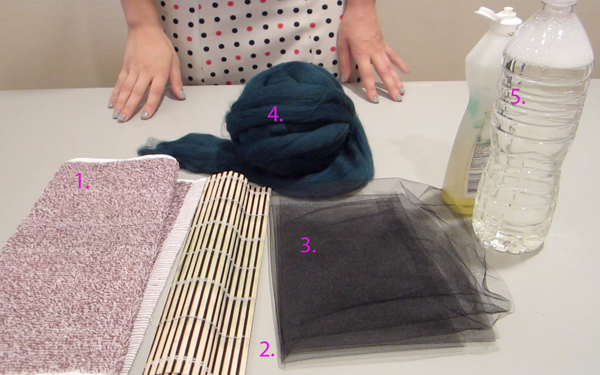In this tutorial, we will learn how to wet felt, the oldest felting technique.
Felt is a non-woven textile, primarily made out of animal fibers. We have found artifacts dating to back from 6,000 – 8,000 years ago, predating woven fabric, which would make felting the oldest form of textile known to our kind.
There are a few different ways to felt today, I am going to teach you how to wet felt, which is the technique that has been used for centuries.
It’s a simple technique that anyone can learn, the main elements of wet felting are:
heat
moisture
pressure
agitation
change in ph
MATERIALS
1. Warm water with a bit of soap, I use a couple drops of dish soap. The water is your heat and moisture and the soap changes the ph level of the fibers. Wool fibers felt easier if they are thrown either towards the basic side or the acidic side, the soap throws it to the basic side.
2. Tulle netting OR any netting that is made of synthetic material. It’s important that it’s synthetic so it does not end up felting in with your work. This material provides agitation and helps keep your fibers in place during the first steps of the felting process.
3. Bamboo placemat OR sushi rolling mat, bubble wrap, textured shelf lining… anything that is textured and can withstand moisture and repeated use. This also aides with agitation and pressure.
4. Roving – this is the fiber that you will be felting with, start with 100% Merino sheep’s wool.
5. Towel to soak up moisture on work table
6. Your two hands, or feet! Yes, you can roll your piece sitting down and using your feet to give your forearms a rest. This is how you will apply pressure to your fibers.
SET UP YOUR WORKSPACE
Lay down a towel to soak up excess water.
Next, put down the material you will roll your fibers in (bamboo mat, sushi mat, bubble wrap, etc.)
Then place your synthetic netting down, make sure you have enough to cover the back and front of your piece. For small pieces I use a big piece of netting and fold over the excess over top once my fibers are laid down.
How to Pull and Lay Down Your Fibers
– Notice the two ways you can pull your fibers in the video. Either grabbing them between your palm and fingertips, pulling out and laying them down, or by holding the tips of the roving down on your work surface in the area you want the fibers and pulling the roving away, leaving a tuft behind. Use which ever one feels comfortable for you.
– Lay them in a criss-cross pattern, forming a felted version of warp and weft for strength and even shrinkage.
– To produce a solid material 1/8″ – 1/4″ thick, I pulled a good amount of fibers with each pull and laid down a total of three layers. Depending on how thin/thick you want your felt to be, this can be adjusted. Make it as thin as a cobweb, or as thick as a phonebook.
– Layer as many colors as you want for beautiful blending effects or go solid, this is where you can paint with the fiber
Now that your fibers have been placed, they are ready to felt together.
How to Roll and Shrink Your Fibers
– Place the synthetic netting over the fibers once you lay them down.
– Sprinkle water with a couple drops of soap over the fibers. Press and massage the water in to the fibers with a small circular motion on the front and back side carefully, as to not upset the lay out of your design,
– Apply downward pressure as you roll
– Roll about 100 times, turn 90 degrees, repeat until you do all four sides of your piece. Piece will shrink in direction you are rolling, so the turning ensures equal shrinkage
– Pull netting away, turn over and repeat the rolling and turning process
– Pinch test the piece, if you can pull any fibers easily away, repeat the rolling process until it is solid
– Shrinkage and how tightly felted you want your piece can also vary, you can leave a piece fluffy if you choose. If kept fluffy, or partially felted, the piece will continue over time anyways due to wear, depending on the application. These can result in some beautiful concepts.
– If rolling a larger piece, try using your feet. Sit in a chair with your back straight and thighs parallel to the ground with knees bent at 90 degrees. roll your whole piece in another sheet, tie the ends and place beneath feet, roll back and forth as you would with your hands.
This is a simple process with lots of possibilities!
Experiment with different fibers, any animal fiber will felt. Try silk, alpaca and mohair. You can also find blends and embed other materials within felt that are not animal derived.
